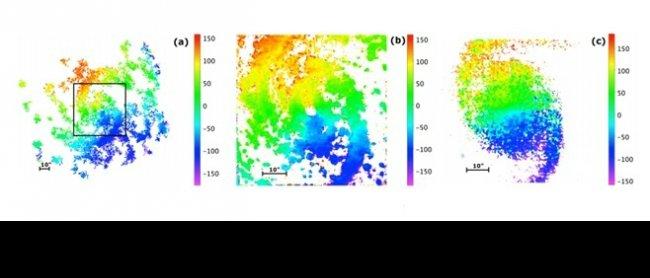Scientists at the Instituto de Astrofísica de Canarias John Beckman and Joan Font have published research in The Astrophysical Journal in which they show, using a new method which they themselves have developed, that spiral galaxies contain resonant waves which determine their structure, notably the form of their spiral arms.
The term resonant waves does not mean literally sound waves, but waves in spiral form which propagate in a concentric circles. They normally move at a different speed from that of the stars, the gas, and the dust in the galaxy. Their resonances are shown by their nodes, the circles along which they move at the same speed as the stars in one of the structures in the galaxy, such as a bar or spiral arms. In this sense they behave rather like the waves which formo n the strings of a violin, or the surface of a drum, which has inspired the authors to refer to them as “the music of the galaxies”.
There are theoretical models to explain the formation of the spiral arms in galaxies, but even now we are still not sure how they arise, and why they don’t disappear after a few rotations of the material in a galaxy about its central nucleus. The confirmation of the role of the resonant waves in the forming of these structures, and the results of the new method proposed by Beckman and Font are a real step forward in understanding them.
The study compares this new method, termed the Font-Beckman method (FB) with a classical method by Scott Tremaine and Martin Weinberg (the TW method). The new technique permits the observers to determine the radii of the resonant circles mentioned above, while TW measures the propagation velocity of the density waves. To show tha FB really works Beckman and Font compared observations of a particular galaxy NGC 3433 obtained with their own instrument GHaFaS, on the William Herschel Telescope of the Isaac Newton Group of Telescopes at the Roque de los Muchachos Observatory, Garafia, La Palma, with observations obtained with MUSE, an instrument on the very large telescope (VLT) at the European Southern Observatory (ESO) in Chile. With GHaFaS they measured the velocity of the gas in the galaxy, and with MUSE the velocity of both gas and stars. The IAC resarchers obtained promising results, the values obtained with the two methods and with both instruments, were in excellent agreement, and in addition, using FB they could measure 4 resonances, whereas with TW only two.
The set of 4 is a resonant symphony which shapes the galaxy disc. “It’s impressive” says Font “that structures as big as the discs of galaxies, which hundreds of thousands of millions of star, together with interstellar gas and dust, work as resonting units”. Beckman goes on to explain that “Our musical notes on Earth have frequencies ranging from a few hundred to a few thousand herz, but the frequencies of the waves in the discs of galaxies are of order, only, of a thousandth of a millionth of a millionth of a herz”.
Article: Beckman et al. Precision Determination of Corotation Radii in Galaxy Disks: Tremaine-Weinberg versus Font-Beckman for NGC 3433. The Astrophysical Journal. DOI: 10.3847/1538-4357/aaa965



